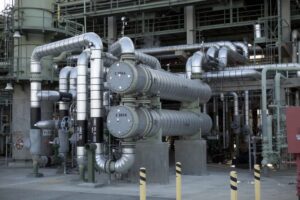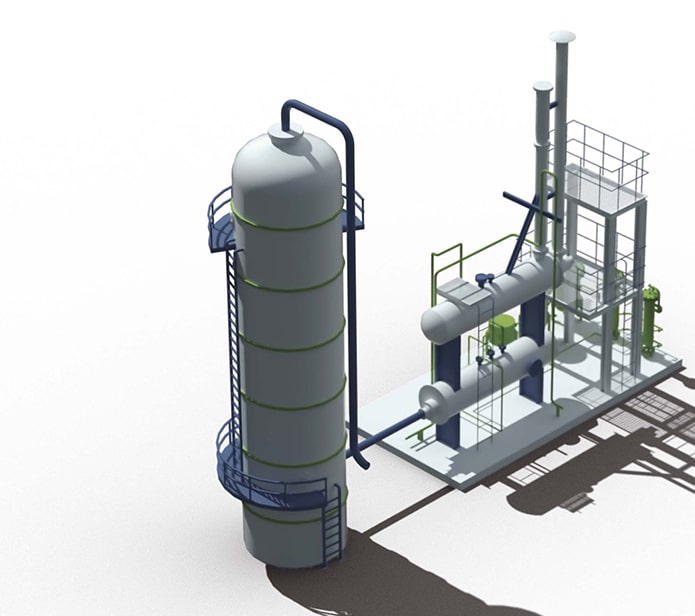An All-in-One Guide to Gas Dehydration Units
Last updated on April 5th, 2024 at 07:18 am
Gas dehydration units are fundamental in the field of oil and gas processing. Before natural gas is used, these units are essential to its extraction and refining, guaranteeing its quality and purity. This extensive blog article provides in-depth discussions of the significance, operation, varieties, and uses of gas dehydration units.
The Basics of Gas Dehydration Units
Natural gas processing plants must include gas dehydration units, also called glycol dehydration units or dehydration towers. Their main job is to extract water vapour or moisture from the natural gas stream, which is essential for several reasons.
- Keeping Equipment from Corrosion: Water in natural gas can cause pipelines, valves, and other equipment to rust, resulting in structural damage and decreased operating efficiency.
- Preventing Hydrate Formation: Under particular pressure and temperature circumstances, water and hydrocarbons combine to produce hydrates, which are solid crystalline substances. Hydrates can clog machinery and pipes, disrupting operations and posing safety risks.
- Fulfilling Pipeline Specifications: Dehydration is a necessary phase in the gas processing process. Many pipeline specifications demand that natural gas have a particular moisture content to avoid hydrate development and corrosion.
Understanding Gas Dehydration Unit Mechanics
One of the two main techniques used by gas dehydration machines to remove moisture from natural gas is as follows:
- Absorption Technique: This process involves passing the gas through a liquid desiccant, most commonly triethylene glycol (TEG), with a strong affinity for water. A dehydrated gas stream is left behind after the gas combines with the desiccant in a contactor tower, absorbing water molecules.
- Adsorption Methodology: Conversely, the adsorption technique uses solid desiccants like silica gel or molecular sieves. These desiccants’ porous shape traps water molecules, enabling the dry gas to pass through while necessitating regrowth regularly to maintain adsorption efficacy.
Gas Dehydration Unit Varieties
Many configurations are available for GDUs, each suited to specific operating demands and specifications. Among the common kinds are:
- The TEG Dehydration Units: These are well recognised as one of the most widely used systems in the industry. They help move TEG via a contactor tower so that it may collect water vapour from the gas stream. Dry TEG is then produced for recirculation after the rich TEG is regenerated in a reboiler.
- Molecular Sieve Dehydration Units: Utilising zeolite-based adsorbents, these units effectively remove water from natural gas. Water molecules stick to the surface of a bed of molecular sieves when gas passes through it. Restoring the molecular sieves’ adsorption capability requires periodic renewal.
- Silica Gel Units: Using silica gel beads as the adsorbent material, silica gel dehydration units work similarly to molecular sieve units. Water molecules are adsorbed as the gas passes over a bed of silica gel; this requires regeneration, accomplished by boiling the absorbed water out of the material.
Numerous Uses: The Adaptability of Gas Dehydration Units
GDUs are gaining traction in various areas of the oil and gas industry, surpassing traditional boundaries.
- Natural Gas Processing Plants: The foundation of the gas processing infrastructure, these facilities use GDUs to strengthen the processed gas’s quality and purity and guarantee that it complies with regulations before being integrated into the distribution system.
- Gas Transmission pipes: Huge transmission pipes are the backbone of gas distribution networks. They require dehydration to comply with strict pipeline requirements and prevent hydrate formation on long trips to customers.
- Storage Facilities for Natural Gas: GDUs are used in storage facilities for natural gas to extract moisture from the gas that has been kept in tanks and caverns. It keeps the storage infrastructure’s structural integrity intact and stops corrosion.
- Offshore Platforms: To ensure that the quality requirements are satisfied before the gas is delivered to onshore facilities, offshore platforms for gas and oil production rely heavily on GDUs to remove moisture from the gas generated.
Sustainability and Environmental Aspects
More eco-friendly dehydration procedures have been developed in response to the oil and gas industry’s rising emphasis on environmental sustainability in recent years. One strategy is to use renewable energy sources, such as solar or wind power, to provide the energy needed for dehydration.
By using renewable energy to power these dehydration machines, the industry can shift towards a more sustainable future by lowering its need for fossil fuels and greenhouse gas emissions.
Moreover, by implementing effective water management techniques, attempts are being made to decrease the environmental impact of dehydration unit operations.
Recycling and reusing water techniques are used to reduce the amount of freshwater and wastewater produced during dehydration treatments. The environmental effects of gas processing operations are lessened by employing desiccants and ecologically friendly chemicals in dehydration units.
Current Technology for Gas Dehydration Units
 The demand for cost-effectiveness, sustainability, and efficiency in the oil and gas sector is pushing technological breakthroughs in gas dehydration. The environmental effect and performance of gas dehydration units are being improved by investigating novel techniques and state-of-the-art approaches.
The demand for cost-effectiveness, sustainability, and efficiency in the oil and gas sector is pushing technological breakthroughs in gas dehydration. The environmental effect and performance of gas dehydration units are being improved by investigating novel techniques and state-of-the-art approaches.
The usage of hybrid dehydration systems, which integrate many dehydration techniques, including adsorption and absorption in a single unit, is one such breakthrough. The benefits of both approaches combined in these hybrid systems are that they maximise dehydration efficiency while lowering energy usage and running expenses.
Furthermore, new desiccant materials with enhanced regeneration and adsorption capabilities have been created as a result of developments in materials science.
For example, researchers are investigating using metal-organic frameworks (MOFs) and materials based on graphene as very effective desiccants for gas dehydration applications. These cutting-edge materials have remarkable water molecule adsorption capabilities, which enable more effective dehydration procedures and lower energy usage.
Obstacles and Prospects for the Future
Although gas dehydration technologies have advanced significantly, there are still several issues that need to be resolved. Managing pollutants and impurities in the gas stream is one such difficulty that may affect the efficiency and lifespan of dehydration units.
Particulate particles, carbon dioxide (CO2), and hydrogen sulphide (H2S) are contaminants that might impede dehydration and call for specific treatment and mitigation techniques.
Furthermore, the design and operation of dehydration units are complicated by the growing complexity and variety of natural gas mixtures. To achieve maximum performance and efficiency, gas streams with unusual compositions or high concentrations of impurities may need specially designed dehydration solutions.
In addition, there are chances for innovation in gas dehydration technologies to fulfil the changing demands of the industry due to the introduction of new gas sources and production methods, such as tight gas deposits and shale gas.
End Note
To summarise, Gas Dehydration Units are the cornerstone of the infrastructure for gas processing, strengthening the natural gas’s quality, purity, and operational integrity along its complex path from extraction to consumption.
By effectively removing moisture from the gas stream, these units mitigate the risks associated with hydrate formation, equipment corrosion, and operational disturbances, promoting the safe and efficient operation of gas processing facilities.
GDUs are at the vanguard of technological and engineering paradigm changes, providing improved performance, efficiency, and dependability to meet the growing needs of the oil and gas sector. GDUs are unwavering in the dynamic energy landscape, representing effectiveness, innovation, and resilience.
FAQs
-
How do gas dehydration units operate when exposed to various operating conditions like temperature and pressure?
Their operating circumstances greatly influence gas dehydration machines’ efficacy and efficiency. Elevated temperatures often accelerate the dehydration process; nevertheless, they may also affect the desiccant materials’ stability. Similarly, changes in pressure can affect the desiccant’s regeneration process and the gas stream’s equilibrium moisture content. Comprehending these impacts is crucial to maximising the functioning of dehydration units in various scenarios.
-
What essential aspects must be considered when choosing a gas dehydration unit for a particular use?
When selecting a gas dehydration unit, many criteria need to be considered, such as the gas stream’s composition and flow rate, the necessary moisture content or dew point, available energy, available space, and environmental concerns. Other elements, including capital and operational expenses, maintenance needs, and regulatory compliance, should also be assessed to guarantee that the best dehydration solution is chosen for the application.
-
How do the types of gas dehydration devices and the desiccant material affect the maintenance and troubleshooting procedures?
The kind of gas dehydration unit (e.g., TEG, molecular sieve) and the desiccant material employed determine the maintenance and troubleshooting methods. For instance, the glycol’s pH, corrosion inhibitors, and purity in TEG dehydration units need to be checked often. They also require pollution filtering and glycol replacement. On the other hand, molecular sieve units may require adsorption capacity monitoring, regeneration cycles, and bed replacement. Understanding these differences is essential to ensuring the dependable operation of gas dehydration devices.
-
How do industry norms and legal requirements affect how gas dehydration units are built and run?
To guarantee environmental preservation, operational dependability, and safety, gas dehydration units must comply with industry norms and legal requirements. These standards could include specifications for materials choice, emissions control, equipment design, and operating procedures. Furthermore, ideas for maximising the effectiveness and efficiency of dehydration units while lowering risks and liabilities may be found in industry best practices and standards.
-
What new developments in gas dehydration technologies and trends are influencing the direction of the sector?
The gas dehydration sector constantly changes because of market, technology, and environmental changes. The design, operation, and maintenance of gas dehydration units are being revolutionised by emerging trends, including the integration of automation, artificial intelligence (AI), and digitisation. Furthermore, developments in desiccant materials, process intensification, and the integration of renewable energy sources are reshaping the gas dehydration technologies of the future and presenting fresh chances for efficacy, affordability, and sustainability.
Many industries use Wattco products to achieve their environmental, economic, and production goals. Contact us to discover which products will best help your application and how we can customize it to meet your needs.

